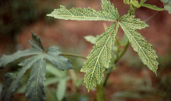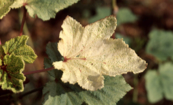DISEASE MANAGEMENT
Yellow vein mosaic / Vein clearing (Vector: White fly – Bemisia tabaci)
|
|
This is the most important factor limiting cultivation of okra throughout India. This viral disease is prevalent wherever the crop is grown especially during the rainy season. If the plants are affected during the early stages of growth, there is a total loss of yield. If infection is found within 35 days of germination, the crop growth is retarded with very few leaves and fruits. Damage may be to an extent of about 94 percent. Plants infected at 50 and 65 days after germination suffer a loss of 84 and 49 percent respectively. The extent of damage declines with the delay in infection.
Symptoms
The major symptoms are vein clearing and veinal chlorosis of leaves. The yellow network of veins is conspicuous and the veins and veinlets are thickened. The veins turn yellow throughout the entire leaf blade. In cases of severe infection, the younger leaves are yellow in colour, reduced in size and the plant remains stunted. Leaves continue to show symptoms as they are formed, throughout the growing season. The infection prevents the formation of flowers and fruits. If formed, the fruits are small, malformed, hard and yellowish green in colour. Such fruits do not fetch a good price in the market. The conditionmay affect many plants in the field and may occur at any stage of the plant's growth. Varieties like Parbhani Kranti, Arka
Anamika, Arka Abhay, Janardhan and Haritha are reported to be tolerant to yellow vein mosaic. No known variety is reported to be completely resistant to the disease. |
 |
 |
The causal agent
The disease is caused by the Yellow Vein Mosaic Virus (YUMA). Normally it is not sap transmissible. But under experimental conditions, it has been transmitted by grafting. Not much is known about the nature and properties of this virus. It is transmitted by white flies (Bemisia tabaci) and the okra leaf hopper (Empoasca devastans). The wild hosts of the virus include rail weed (Croton sparsiflora), and goat weed (Ageratum sp).
Disease cycle
The insect vectors transmit the virus from wild hosts to the main crop. The disease is not seed borne. A continuous cycle is maintained through wild or cultivated hosts. Climatic factors favour the population build up of vectors and the prevalence of wild hosts.
Management
- Cut a cactus like nawagalli (Euphorbia nivulia) or milk bush (E. tirucalli) into pieces, immerse in water (just enough for the pieces to float), allow to ferment for 15 days, filter and spray.
- Control the vector by spraying 5% neem seed kernel extract or ginger, garlic and chili extract.
- Destroy weeds and other wild hosts wherever possible.
- Remove the affected plants from the field and burn them.
- Avoid summer season planting.
- Plant resistant varieties like Parbhani Kranti, Arka Anamika,
VRO-5, VRO-6 and Pusa A-4 (Co-2 is susceptible to YVM).
|
Cercospora leaf spot (Cercospora abelmoschi, C.malayensis, C.hibisci, C.hibiscina)
|
|
Several species of Cercospora are reported to cause spots and blight. The pathogen affects the crop often during humid weather conditions and causes defoliation. C. abelmoschi produces no definite spots but produces a sooty black mould on the lower surface of the leaves. C. malayensis produces irregular brown spots with a grey centre and dark margins. The fungal spores survive as conidia and stomata on crop debris. A temperature of about 24–29 oC is highly conducive for infection.
Management
- Clean and trim all the bunds. • Spray 10% cow urine or 5% neem seed kernel extract.
|
Powdery mildew (Erysiphe cichoracearun)
|
|
A fungal disease, characterized by grey-coloured powdery growth on both the upper and lower surface of the leaves. It severely affects the yield of the crop but can be controlled by applying 10% lime water. |
Root knot nematode
Causal organism: Meloidogyne incognita, M. javanica
|
|
Disease incidence is widespread in both summer and spring in north India. Root knot or root galls caused by nematodes are a common disease of many vegetables in tropical and sub-tropical climates. An infection weakens the plants and pre-disposes them to the invasion of many root rot and wilt causing fungi and bacteria, thus compounding the damage.
Symptoms
The plants remain pale and stunted, and pod set is very low. The leaves are yellowish green or yellow in colour. Drooping, sudden wilting together with a scorching of leaves from the margins inward can be observed. Formation of knots or galls in the root system is a characteristic symptom. The maximum number of galls per plant and number of females and egg masses per gram of root occur when the plants are infected at 2-week stage. The main root and the laterals have spherical or elongated galls of various sizes. In advanced stages of infection, the tissues decay and are attacked by other pathogenic and saprophytic organisms.
Cultivars like long green smooth, IC-9273 and IC-18960 are reported to be resistant to root knot nematodes. Causal agent Meloidogyne incognita is abundant in cooler and warmer areas whereas M. javanica is common in warmer areas. The nematodes are sedentary endoparasites of roots. The female lays eggs in the host root tissues in masses or egg sacs. The eggs are dormant and do not hatch immediately. An average of about 400–500 eggs are found in a single egg mass. The eggs hatch under suitable environmental conditions. Newly hatched larvae are small, slender and about 0.3–0.5 mm in length. Their movement in the soil is slow and on contact with host roots the larvae enter the roots just above the root cap. Upon entering the roots, they move between the undifferentiated cells and reach the endodermis where they become sedentary. They eject secretions while they feed on the cells, which cause enlargement of cells or formation of galls. It is very difficult to control nematodes in an infested field since the eggs survive in the soil and are protected by host tissues. They are introduced through infected seedlings and by shifting soil from neighbouring infested fields.
Management
- Crop rotation – There is a wide host range for nematodes. With cereals, there is a definite reduction in the population.
- Intercropping with marigold is helpful in minimising the infestation.
- Add organic amendments like neem cake @ 25 q/ha.
- Fungal species such as Paecilomyces lilacinus and Verticillium and the bacterium Bacillus penetrans can be
used as bio-control agents.
|
Other minor diseases
|
|
Fusarial wilt : Fusarium oxysporum f. sp. vasinfectum
Damping off : Pythium sp.
Fruit rot : Pytophthora sp., Pythium sp.
Leaf spot : Alternaria hibiscinum, Phyllosticta hibiscini
Anthracnose : Colletotrichum capsici, C. hibisci |
|
General management of diseases
|
|
- Spray mint leaf extract (250 gm of leaf powder in two litres of water)
- Spray 10% cow urine thrice at 10 day's interval
- Spray 5% neem seed kernel extract
- Fuigated with vaividanga (Embelia ribes) or sweet flag (Acorus calamus) twice during the evening hours.
|
|
Other disorders
|
|
Pod discolouration
When okra pods are discoloured (light yellow or white), spray leaf extract of mesquite (Prosopis juliflora) diluted with water. |
|
Source : Centre for Indian Knowledge Systems, Chennai
Updated on : Dec 2014 |

